Published On August 22, 2019. Last Updated on June 26, 2024.
The term, intuitive has multiple meanings and connotations. It can refer to that which is “readily learned or understood,” according to Merriam Webster. With it’s responsive engineering that is attuned to individual skin thickness differences, the Dr.UGraft ™ system (i.e. central Revolution console, combined with the Dr.UGraft ™ intelligent punch and Nurture ™ handpiece) represents the world’s first ever Intuitive FUE hair transplant technology, learning or understanding the skin thickness of the donor site so that the practitioner can then adjust performance settings in order to effectively reduce graft transection to the lowest possible rates. By lowering the chances of graft damage, better growth coverage is then possible for patients.

The Dr.UGraft hair transplant technology system is built on the principles of Intuitive FUE
Intuitive FUE, A Breakthrough Paradigm In Hair Transplantation
As an ideology developed by Sansui Umar MD (Dr.U), Intuitive FUE attributes the primary cause of graft transection to skin thickness. Prior to this, surgeons believed hair shaft morphology (i.e. curliness, waviness etc.) to be the main explanation. By designing his Dr.UGraft ™ technology around the new paradigm of Intuitive FUE, Dr.U has found an effective approach for successfully lowering transection rates across a wide range of patient challenges for both head and body hair.
Before the inception of Intuitive FUE doctors thought that using a cylinder-shaped hair transplant punch would be difficult when tracing the curvatures of curly hair from the skin’s surface down to the follicle, especially since the direction of the hair changes unpredictably beneath the skin. The exact position and orientation of the graft can easily be misjudged. This type of human error becomes a much bigger factor when harvesting graft pools in the hundreds or thousands. Thus regular FUE punches have been regarded as better suited for straight hair.
Through a closer look, it is actually apparent that an entirely new variable, the thickness of the patient’s skin provides a more closely fitting explanation behind hair transplant graft transection.
After observing numerous patients of various ethnicities, Dr.U discovered compelling forms of support for the notion of skin thickness as a major contributor to damaged grafts.
As an illustration, consider the example of a Middle Eastern patient with relaxed, wavy hair versus an individual of African heritage with tightly curled hair. It would seem that that the tighter the curl, the harder it would be to use a basic punch to safely encompass the follicular unit graft. With this picture, one would probably assume that the patient with Afro-textured hair would produce a rather high transection rate.
Dr.U observed the exact opposite to be true in instances where individuals with more relaxed hair types (e.g. Middle Easterners) actually experienced remarkably much higher transection percentages.
Likewise, notable damage rates were observed in patients on the other extreme end of the spectrum who possess very soft skin.
These types of situations contradict the notion of hair texture as the leading explanation of hair transplant graft transection. It becomes quite clear that a brand new approach would be necessary to address the many variations of skin thickness across the different patient demographics.
Intuitive FUE In The Form of A Game-Changing Technology
In the context of technology, the term intuitive not only refers to the ease of learning or understanding different situations, conditions and needs, but more importantly to effectively respond to these contexts.
Thus, the ability to adapt is critical for address the issue of skin thickness as the main cause of graft transection in FUE hair transplant surgery.
To devise a technology-based solution for achieving this objective , Dr.U worked alongside his team of engineers to develop a new type of rotary punch for graft extraction. His Dr.UGraft™ system is built so that the practitioner is able to modify how the punch performs in order to reduce graft transection to the lowest rates possible.
Customizable Speed and Torque Parameters Replaces a Singular One-Size-Fits All FUE Punch Rotation
Conventional FUE rotary punches are built with a single speed and torque. According to Dr.U, however, this is analogous to driving a car at one speed one one gear mode. While this may suffice on a continuous, flat level road, different needs emerge on more challenging territories characterized by hills and bends in the road and rugged terrain. These various other driving conditions are very much like performing FUE hair transplant extractions on different levels of skin thickness.
All the different variations in skin density can be thought of as a spectrum on the x-axis of the bell-curve model. In the middle is the average range skin-thickness phenotypes which comprises the majority of of individuals. Both ends of the bell curve (extreme skin thickness and softness) represent the less-common characteristics. Yet, these tail-ends of the bell curve still represent a significant portion of individuals that cannot be ignored or dismissed.
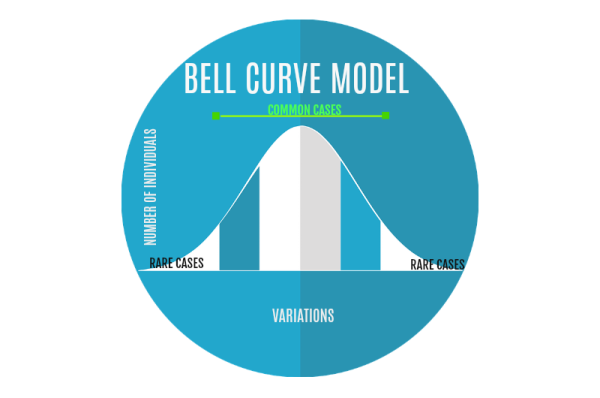
Very thick skin and very soft skin types represent the extreme ends of the variation spectrum on the bell curve model
For average, or common skin thickness, A standard punch is capable of performing adequately well. However, on very dense skin, or skin that is extremely soft, this instrumentation is more likely to incur very high transection rates.
Thicker skin tends to have more densely packed filaments which anchor the follicular unit to its surrounding tissue environment. A regular FUE punch which rotates at just one speed and torque will be met with greater resistance as the practitioner tries to penetrate the skin. The strongly held filaments will be difficult to sever when attempting to complete the excision to free the graft. Continued efforts will then increase the likelihood of tearing the outer protective sheath which surrounds the follicular unit.
On the other end of the spectrum, with very soft skin, the fixed speed and torque of a regular punch will exert an overwhelming amount of force as it penetrates downward. This heightened exertion presents yet another risk factor which is also likely to result in graft damage.
To overcome these problems, the Dr.UGraft ™ system is designed so that the operator can choose to increase or decrease the speed and torque settings to normalize punch’s performance according to the patient’s skin type.
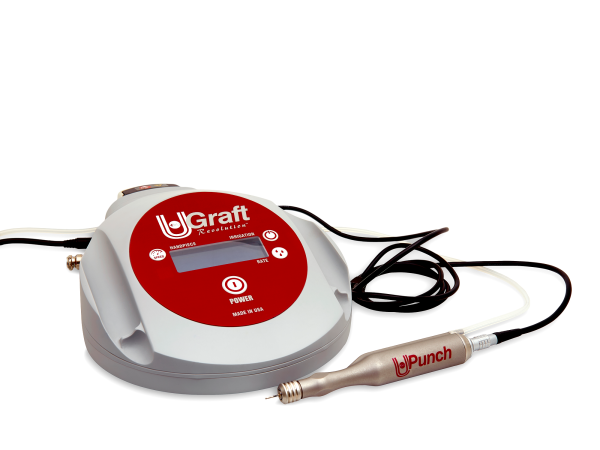
The button settings on the central Dr.UGraft Revolution console allow the operator to adjust the speed and torque of the rotary punch.
At the start of the procedure, the punch is set at low baseline parameters so that its performance can be observed. If the punch is slowing down drastically as it works its way down to the graft, it is very likely that it is working through skin that is very dense. The operator then able to incrementally increase the speed using the settings of the Dr.UGraft ™ Revolution console. If the turning rotation of the punch slows due to the thickness of the skin, the torque can be increased.
On the other hand, in donor skin areas that are much softer than average, a different set of behaviors may occur. The punch may descend at an exceedingly rapid rate. Also with less resistance in softer skin the turning rotation may also be faster than normal. Again, the practitioner would be able to reduce the speed and torque to avoid damaging grafts using the button controlled settings on the Dr.UGraft ™ console.
Ensuring Dependable Hair Transplant Success For All Black Patients And Ethnic Groups
Producing successful hair transplant results on individuals of African descent has long been considered a major challenge. As with all demographics, the strip method is one option to consider. The downside of this approach is that it leaves a noticeable linear scar. This remains quite visible through the shortly cropped hairstyles preferred by most black men.
Also, it should be noted the strip technique does not result in better graft survival. Many patients of all backgrounds seek Dr.U’s help to repair continued baldness or thinning after having undergone previous strip surgeries performed at other clinics, due to the non-survival of their grafts.
The only other alternative to strip surgery available to patients is FUE hair transplantation. Using the conventional punch technology of FUE surgery, individuals of African origin could only hope to meet their vision for desired growth outcomes with about a 50/50 probability of success. Again, as discussed earlier, this is due to the exceptional denseness of their skin.
With the pivotal turning point made possible by Intuitive FUE, the challenges of performing excisions on thicker-than-average skin is no longer a barrier. For even more difficult black patient cases, there is also the option to have the punch’s rotation oscillate between clockwise and anticlockwise directions as a yet another mode for effectively severing the connective fibers surrounding the graft.
Below are actual images of Dr.UGraft ™ Intuitive FUE hair transplant results achieved for patients of African descent.
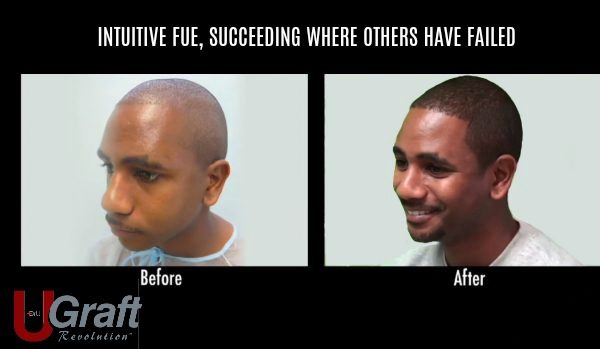
Intuitive FUE helped this patient successfully restore the youthful looking coverage that he sought
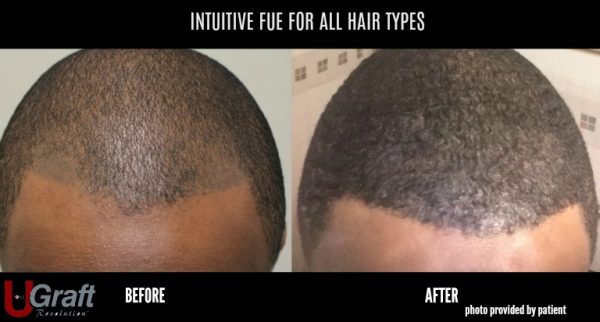
The Intuitive FUE capabilities of this patient’s Dr.UGraft hair transplant helped him attain real hair growth to cover unwanted scalp tattoos.
The Dr.UGraft’s unprecedented ability to adjust the performance of the intelligent punch based on skin thickness type allows all black patients to reliably anticipate the growth coverage that they planned for, instead of taking their chances and hoping for the best.
Intuitive FUE, A Necessity For Body Hair Extractions
Body hair is a resource capable of expanding the existing donor supply for patients who require a greater number of grafts beyond their available scalp quantities. In particular, these include cases such as:
- Severe baldness
- Hair transplant repair
- Young patients who require additional resources for future surgeries.
Dr.UGraft’s capacity to customize the punch’s impact on the skin tissue to avoid unnecessary graft damage makes it possible to safely extract thousands of supplementary grafts to achieve the patient’s coverage goals.
Intuitive FUE not only applies to skin thickness differences across patients, but also to different skin donor areas in different parts of the body within the same individual.
For example, the scalp is characterized by skin that is thicker than the face and neck. Interestingly, Dr.U has noticed that some regions of the same patient’s scalp may experience higher transection rates than others. This further supports the contention that overcoming skin thickness differences is absolutely necessary for harvesting healthy, viable grafts.
As an Intuitive FUE technology, Dr.UGraft ™ offers the versatility of accommodating different skin thickness terrains, whether it is used across patients or within the same individual. This system represents an indispensable resource for safely procuring large quantities of body hair grafts at scale.
Here are photos of actual patient results made possible by the Dr.UGraft’s Intuitive FUE feature set.
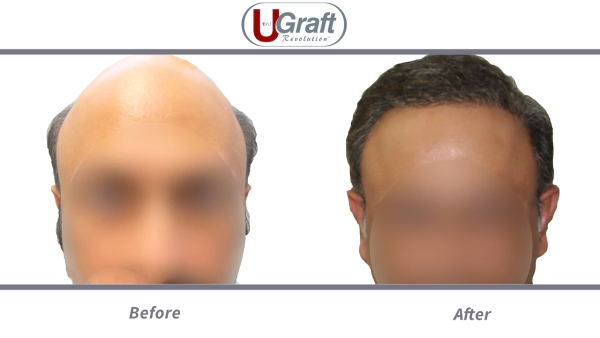
Intuitive FUE enables large quantities of body hair to be safely extracted to restore cases of severe baldness *
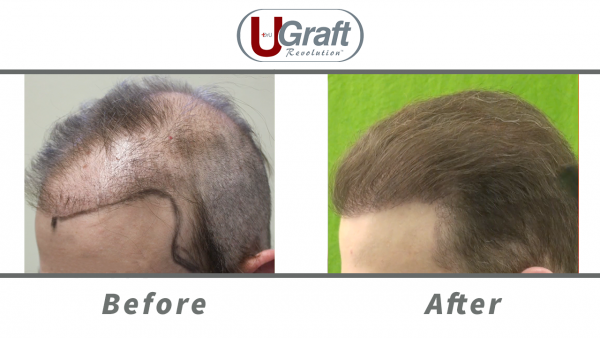
The safe harvesting of body hair can make an enormous difference for challenging repair cases *
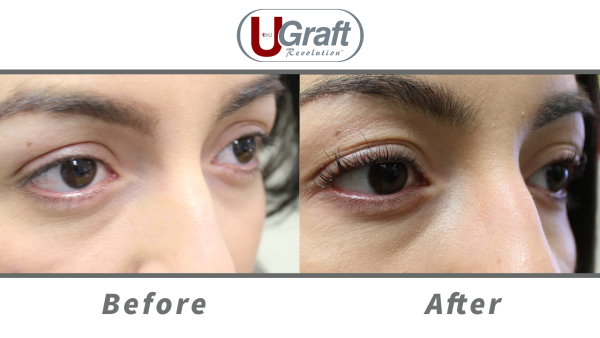
Adjusting for skin thickness differences on various body parts like the legs allows more hair type options which can be desirable for regions like the eyelashes*
Frequently Asked Questions
Does the Dr.UGraft ™ system have the ability to account for hair angulation and curvatures, apart from skin thickness?
Yes. Although skin thickness is the leading explanation for graft transection, challenging hair angles and bends may also contribute to damage rates, depending on the nature of the patient case. The Dr.UGraft ™ intelligent punch is capable of self-navigating any type of hair angle or curvature and surround the graft with minimal input from the operator since it is built without the need to rely on the hair shaft to accomplish this.
What is the purpose of the intelligent punch’s flaring within the context of Intuitive FUE?
The flaring of the punch tip serves as an additional safety feature for ensuring the graft’s safety during the excision process. This design feature works to consistently avert the direction of the cutting edge away from the graft.
How else does the Dr.UGraft ™ system prevent graft transection aside from its Intuitive FUE capabilities?
Dr.UGraft ™ technology also prevents a specific type of transection which is torsion based This occurs when the base of the follicular unit grouping remains anchored at the base to its tissue environment, while the top part has been liberated by the rotational excision of the punch. Due to frictional forces, the upper portion may adhere to the inner lining of the punch. Continued rotation will, in essence, cause the top part of the graft to twist off. The Dr.UGraft ™ system allows operators to direct a flow of physiologic fluid which lubricates the punch tip and prevents the friction which contributes to torsion-based transections.
Further Reading
Learn more about the comprehensive set of features offered by the Dr.UGraft ™ technology system
